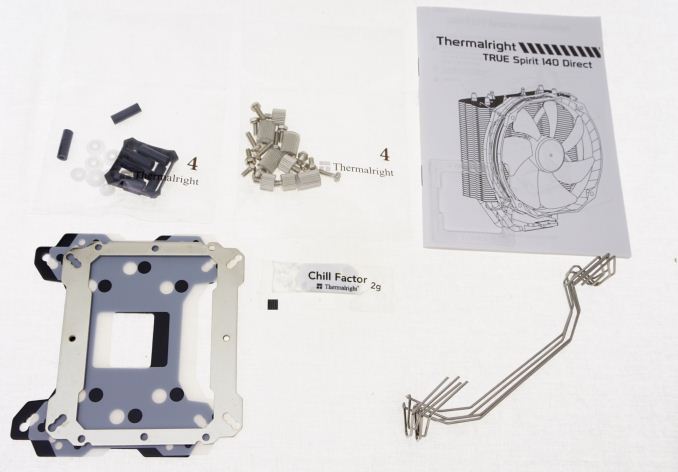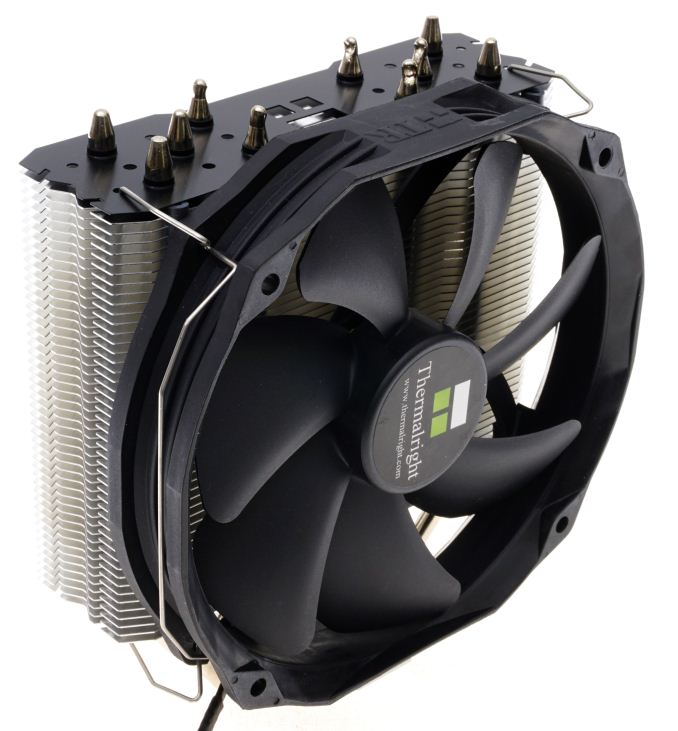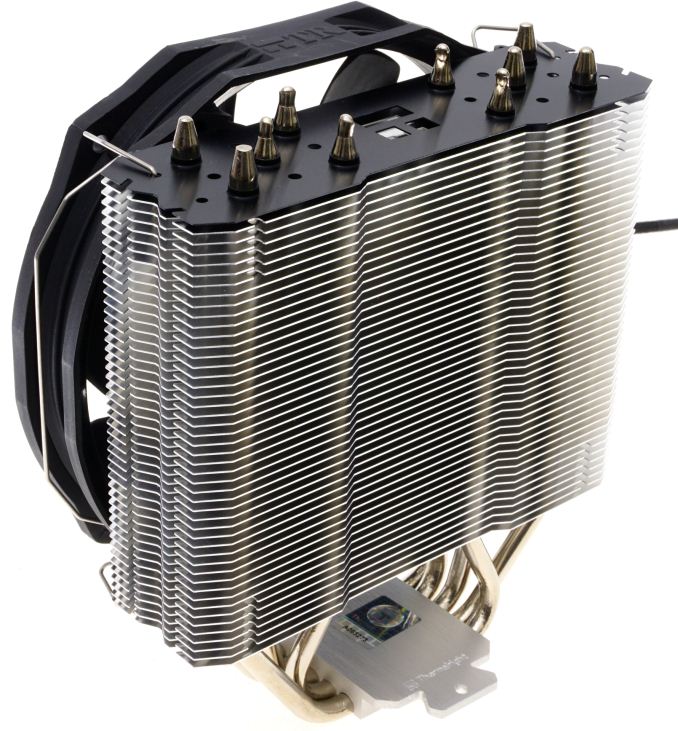The 140mm Slim Tower CPU Cooler Roundup: Thin & Light Done Just Right
by E. Fylladitakis on May 24, 2017 8:00 AM EST- Posted in
- Cases/Cooling/PSUs
- be quiet!
- Noctua
- Phanteks
- Cooler
- Thermalright
Thermalright True Spirit 140 Direct
Thermalright is practically a newcomer here in AnandTech, as we have not looked at any of their products since 2010 and our last Thermalright CPU cooler review is now nearly a decade old. The cooler that we will be reviewing today is the Thermalright True Spirit 140 Direct, the upgraded version of their popular Thermalright True Spirit 140 cooler. It comes supplied inside a dark box with minimal artwork, only a clear picture of the cooler itself and icon denoting its most important features.
Inside the box we only found the absolute necessary parts for the installation of the cooler, which are a one-fits-all backplate, mounting hardware, fan support wires, fan anti-vibration standoffs, and a small but detailed installation manual. Thermalright also supplies one dose of their “Chill Factor” thermal compound.
Much like Noctua’s and Be Quiet!’s offerings, the Thermalright True Spirit 140 Direct has a single 52 mm deep fin array with a 140 mm fan attached on it. The fin array is relatively simple, with only a recessed center area to reduce the aerodynamic drag noise. The top fin of the array has been painted black for aesthetic purposes. It has five 6 mm nickel-plated heatpipes.
Thermalright is using one of their TY-140 cooling fans on the True Spirit 140 Direct. The TY-140 is a PWM general purpose cooling fan that has been initially designed with 120 mm mounting holes to maximize compatibility. The company advertises its “Enhanced Hyper-Flow Bearing (EHFB)” engine as consistent and highly reliable, without any further information regarding its design and/or mechanics.
The fan mounting mechanism is strange, with the fan having to sit on rubber standoffs that need to be inserted into small cutouts on the fin array. It is not possible to mount the fan without these standoffs. Hopefully the rubber that they are made of will last for several years, but replacements may be necessary for people who keep their hardware for more than a few years or if they are lost. (Tip: Pieces of large drinking straws do work as a temporary solution)
The large difference between this cooler than the others in this roundup review (and also its major upgrade over the previous version) is the design of its base. Instead of having a contact plate coming in contact with the CPU and the heatpipes attached to it, the heatpipes of the True Spirit 140 Direct are in direct contact with the CPU itself. The top part of the base is made of machined aluminum and only provides mechanical cohesion and retention bracket support.
















74 Comments
View All Comments
JoeyJoJo123 - Wednesday, May 24, 2017 - link
For online comments, there's shills, then there is everyone else. Shills which are just trying to spread around this meme that X company's products are the best thing sliced bread.Just buy whatever you want, regardless what anyone else thinks. Don't pay brands any particular attention, just buy the best product you can for the best price you can and pocket your savings.
mgilbert - Wednesday, May 24, 2017 - link
Nice, mature response, with the name calling and all. Grow up, then read the actual review. The reviewer said the same thing I did. Now, go read a few more reviews of coolers, and you'll find that virtually all of them agree with this review. Noctua is expensive, but worth it. Generally I agree with you - it doesn't pay to go by brand name - but there are exceptions, and Noctua is one of them.close - Wednesday, May 24, 2017 - link
Noctua also costs a lot more than the competition. So when you're adding 35% to the price tag of any of the other products tested then you usually expect better performance (not mandatory though). So drawing the conclusion that Noctua is king of the hill in general isn't that useful.So... there are expensive products, then there are cheaper products :). For some people 35% markup might not be worth the extra performance.
WinterCharm - Thursday, May 25, 2017 - link
So? If you want the best you often have to pay more for it.The "best" is the best.
If you want the "best within a price bracket" THEN you can finagle and weigh things against each other.
JoeyJoJo123 - Wednesday, May 24, 2017 - link
Does Noctua pay you in stock, dividends, or a salary to promote their products online? If not, why do you go out of your way to promote free advertising to another company who you owe nothing to? You made your trade; your money for their product, there's no stipulation that you have to continue to sing praises for their company for other people to be more negotiable to give that same company more money for more products.Likewise, if you're upset about being called out on literal shilling, then it's really you that needs to grow up.
Additionally, the performance roundup review written by E. Fylladitakis doesn't have anything in common with your post, which you attribute as stating that "(t)he reviewer said the same thing I did". Fylladitakis makes no catch-all branding statement. They evaluate the four products, they make the measurements, they compare the measurements, then make a conclusion about the products based on the measurements.
YOU, however, are making a blanket statement about all performance CPU cooling products developed by Noctua being "superior in virtually every respects, especially quality and support."
Those statements can't be anymore unalike in any way. The former was a controlled experiment to evaluate product performance followed by an analysis of the products, the latter (your comment) is an opinion; void of any metric of data or analysis.
If you look at the thermal performance in this roundup, it shows that the Thermalright cooler (at $47, the cheapest of the four measured in this roundup) to have the best thermal performance at low temperature loads (where most performance PCs, the target audience of these $50 tower cooling solutions, stay outside of gaming or benchmark loads), theorized by Fylladitakis to be due to the direct contact design of the heatpipes, and a close-second (literally 16.6 vs 16.8 degrees Celsius delta over ambient, figures well within a margin of error of measurement) at 150W loads (where most overclocked mainstream CPUs will sit at full load), and still competes closely at completely unrealistic synthetic 340W loads.
So given a $47 price for the Thermalright vs $65 price for the Noctua, given similar performance figures, it's pretty apparent which has the better value for mainstream performance PCs.
Ryan Smith - Wednesday, May 24, 2017 - link
I love a vigorous discussion, but you guys need to cool it, please. There is no place for profanity here on AnandTech.mgilbert - Wednesday, May 24, 2017 - link
Yet, my post gets deleted, but not his, despite its divisive, hateful, argumentative, obtuse, disrespectful, inappropriate nature. Sounds like four letter words aren't the only thing not allowed on Anandtech. Fairness has no place, either.Ryan Smith - Wednesday, May 24, 2017 - link
I have made my ruling. I give you guys exceptional leeway as I believe you need to be free to discuss technical matters, but I draw the line at profanity and pointless ranting. You guys are done, please move on.If you wish to discuss it in private please email me.
fanofanand - Thursday, May 25, 2017 - link
We love you Ryan! Even when we complain, whine and moan about x, y, or z not being tested the specific way WE would do it, we love you!Ruh-roh, now I"m shilling for Anandtech! Don't worry, my username checks out.
JackNSally - Wednesday, May 24, 2017 - link
I have to agree, Noctua is the best. I do recommend the Hyper 212 for budget builds though.